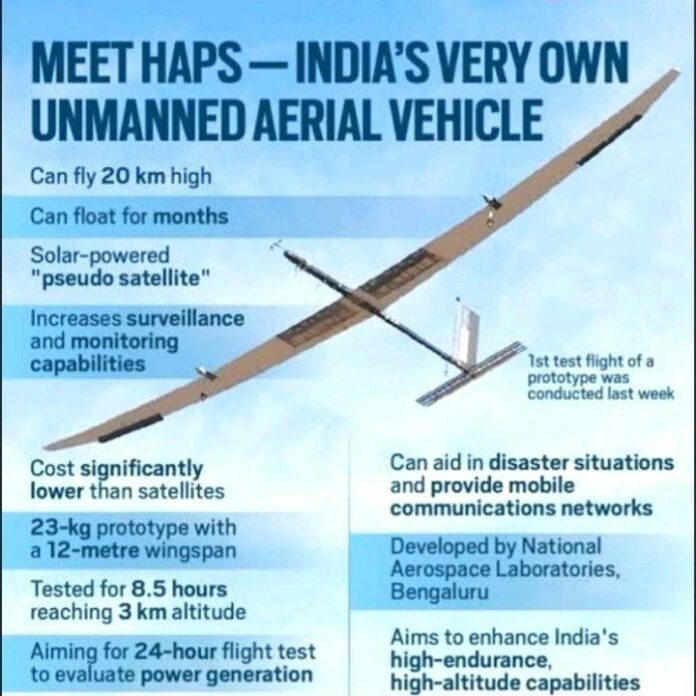In a significant leap forward for aerospace technology, India has unveiled its latest innovation—HAPS, a state-of-the-art unmanned aerial vehicle (UAV) that promises to redefine the landscape of high-altitude surveillance and communication. Developed by the National Aerospace Laboratories (NAL) in Bengaluru, HAPS (High-Altitude Pseudo-Satellite) is poised to enhance India’s capabilities in both civilian and defense applications, marking a major advancement in the country’s aerospace and defense sectors.
A Technological Marvel
HAPS stands out for its impressive technical specifications and capabilities. This solar-powered “pseudo satellite” is designed to operate at altitudes of up to 20 kilometers, far surpassing the reach of conventional UAVs and even rivaling the heights at which traditional satellites orbit. With its 12-meter wingspan and lightweight design of just 23 kilograms, HAPS offers a unique combination of endurance, altitude, and cost-effectiveness.
The prototype, which underwent its first test flight last week, demonstrated remarkable performance. During the 8.5-hour test, HAPS reached an altitude of 3 kilometers, showcasing its potential for sustained high-altitude operations. The next phase aims to achieve a 24-hour flight to thoroughly evaluate the vehicle’s power generation and endurance capabilities, crucial for its long-term operational viability.
Cost-Effective Innovation
One of the standout features of HAPS is its cost-efficiency. Unlike traditional satellites, which can incur significant costs for launch and maintenance, HAPS offers a more affordable alternative. Its solar-powered design reduces operational costs and extends its flight duration, making it a cost-effective solution for prolonged surveillance and communication needs.
Expanding Capabilities
HAPS is set to play a transformative role in various applications. Its high-altitude flight capability allows for extended surveillance and monitoring, providing a significant boost to India’s efforts in border security, environmental monitoring, and disaster management. In emergencies, HAPS can offer critical support by providing mobile communication networks and enhancing situational awareness.
Furthermore, its ability to float for months at high altitudes means that HAPS can act as a persistent surveillance platform, offering continuous coverage without the limitations faced by conventional UAVs or satellites. This capability is particularly valuable in areas where infrastructure is lacking or in regions that are difficult to access.
Developed by National Aerospace Laboratories
The development of HAPS by the National Aerospace Laboratories in Bengaluru underscores India’s growing prowess in aerospace technology. As a pioneering project, HAPS reflects NAL’s commitment to advancing high-endurance, high-altitude capabilities and positioning India as a leader in innovative aerospace solutions.
The successful test flight of the HAPS prototype marks a significant milestone, and the future looks promising as the technology progresses towards full operational capability. With ongoing advancements and rigorous testing, HAPS is set to become a cornerstone of India’s aerospace strategy, enhancing its surveillance and communication infrastructure while paving the way for future innovations.
Looking Ahead
As India moves forward with the development of HAPS, the focus will be on refining its performance and expanding its operational capabilities. The aim is to establish HAPS as a reliable and versatile asset for both national security and civilian applications. With its potential to revolutionize surveillance and communication, HAPS represents a bold step into the future of aerospace technology, reflecting India’s commitment to innovation and excellence.
In conclusion, HAPS is more than just an unmanned aerial vehicle; it is a symbol of India’s ambition to push the boundaries of what is possible in high-altitude, high-endurance technology. As the project progresses, it is poised to make a significant impact on various sectors, reinforcing India’s position on the global stage as a leader in aerospace innovation.




